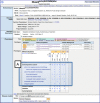Mouse genome database 2016
- PMID: 26578600
- PMCID: PMC4702860
- DOI: 10.1093/nar/gkv1211
Mouse genome database 2016
Abstract
The Mouse Genome Database (MGD; http://www.informatics.jax.org) is the primary community model organism database for the laboratory mouse and serves as the source for key biological reference data related to mouse genes, gene functions, phenotypes and disease models with a strong emphasis on the relationship of these data to human biology and disease. As the cost of genome-scale sequencing continues to decrease and new technologies for genome editing become widely adopted, the laboratory mouse is more important than ever as a model system for understanding the biological significance of human genetic variation and for advancing the basic research needed to support the emergence of genome-guided precision medicine. Recent enhancements to MGD include new graphical summaries of biological annotations for mouse genes, support for mobile access to the database, tools to support the annotation and analysis of sets of genes, and expanded support for comparative biology through the expansion of homology data.
© The Author(s) 2015. Published by Oxford University Press on behalf of Nucleic Acids Research.
Figures





References
-
- International Mouse Knockout Consortium. Collins F.S., Rossant J., Wurst W. A mouse for all reasons. Cell. 2007;128:9–13. - PubMed
Publication types
MeSH terms
Grants and funding
LinkOut - more resources
Full Text Sources
Other Literature Sources
Research Materials

